Unusual tanks of Russia and the USSR. Four-Track Tank 279 Object
Excursion in history
Before we write about our hero, we will make a brief excursion into history. The idea to put a tank on 4 tracks existed for a long time. The first thought about the quadricep was owned by the German company Daimler, which during the First World War decided to develop the first off-road armored car, for which a variant was proposed with installation on trucks instead of rear wheels of tracks. The idea seemed good and the military already in 1915, an order was issued for the construction of such a machine. To increase the “Marienwagen” passability - this name was given to this car - it was decided to put tracks on 4: on the 2 in front and 2 in the back. However, the attempt was unsuccessful. It was impossible to hoist a rather impressive box of 9-mm armored steel on the flimsy chassis. Yes, and the tank could call this car with a stretch, because it did not have a tower, rather it was an armored car, but on 4 tracks.
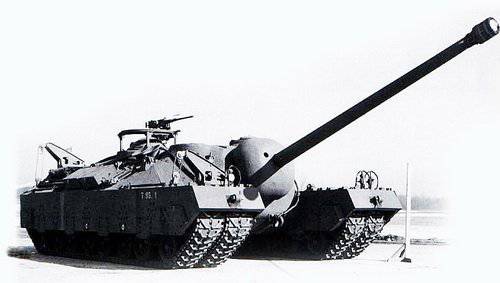
The second, who picked up the idea of creating a four-track tank, turned out to be the British. According to their concept, tanks were a kind of "land fleet", And, therefore, in the tank forces, as in the navy, there should have been a kind of leader, invulnerable to artillery fire. The British began to develop such a tank in 1915. As a result of their work, a huge tank was born: a length of about 10 meters, weight under 100 tons. It looked like a massive armored carriage on four tracks. In motion, 2 engines with a total power of only 210 hp were supposed to drive it, so any mobility could be forgotten. The tank was armed with a 57 mm cannon and 6 machine guns, which created a solid wall of fire around it. Despite the fact that booking the tank protected him from the fire of German 77-mm field guns, almost immediately after the tests, the tank was sent for scrap.
American version of the T-28 (T-95)
The third who threatened to create a tank on the 4 tracks, became the Americans. In 1943, in the United States, a program was launched to develop heavy tanks T-28, which could easily overcome any defense, even such as strong as the "Western Wall" or "Siegfried Line". The main armament of the tank was to be the 105-mm gun, but again it was not located in the turret, but in the hull itself. In fact, the Americans developed not a tank, but a PT-ACS. The gun was located in the body between the tracks and covered with the most powerful armor in 305-mm. As a result, the car was retrained in self-propelled guns and received a new T-95 index.
The combat weight of the machine was 86 tons, so to reduce the pressure on the ground, it was decided to use 4 tracks: in pairs, 2 on each board. At the same time, the external tracks of the self-propelled guns were protected by 100 mm thick side panels attached to them and could be removed and towed behind the car on a cable. Removing the tracks also facilitated the transportation of the T-95, as it significantly reduced the width of the machine from 4,56 m to 3,15 m. A total of 2 machines were manufactured that were used only for testing. One of them can still be seen at the Patton Museum in Fort Knox, Kentucky.
279 object
At the beginning of 1956, the Main Armored Directorate of the USSR Ministry of Defense formulated the basic tactical and technical requirements for the new heavy tank, which was to be put into service at the turn of 50-60. In particular, the weight limit should have been 50-60 tons, while at the same time it was planned to equip the tank with a new 130-mm gun. The technical task for the development of the tank was issued 2-m KB: Chelyabinsk Tractor Plant and Leningrad them. Kirov. The selection should have been on a competitive basis.
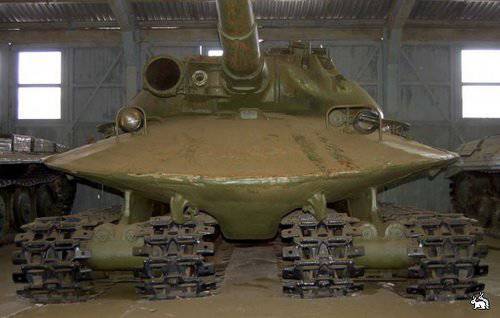
In the 1950-ies in the Soviet army there was a difficult situation with heavy tanks: 4 models were in operation. The IS-2 tank, which remained from World War II, no longer met the requirements of the time (mainly in terms of security) and in the future was suitable only for service in the role of pillboxes. The EC-3 had low reliability, so it was not popular among the troops, and in terms of booking it was only slightly different from the average T-54 tank adopted for service. The existing EC-4 tank was a protected and powerful machine, but it cost 3 times more expensive than the EC-3, while not arranging the military for mobility requirements and, like technical problems, the EC-3. All three existing heavy tanks had the X-NUMX-mm D-122T rifled cannon as the main armament, which by that time was already noticeably outdated. Along with them, he tried to take the place of the main heavy tank T-25, which was produced huge for this class of equipment series. This tank suited the military for its operational qualities, but could not withstand comparisons with its NATO counterparts — the British Conquerer and the American M10, at least until the upgrade to the T-103M level.
Created a tank had to replace all the existing machines and lose the main drawback of the T-10 - weak body armor and effectively deal with all existing and prospective tanks of a potential enemy. In the 1957-1959, the 3 prototype was introduced, but only one of them, the 279 Object, was created anew, becoming one of the most unusual and bold models in the entire history of world tank design.
The design work on the project was headed by L. S. Troyanov, who was already noted for the creation of the heavy tank EC-4. Unlike competitors' projects (770 Object - ChTZ and 277 Object - another project of the Kirov plant), its heavy tank was intended for use in the conditions of use by the enemy of nuclear weapons and on difficult terrain for vehicles.
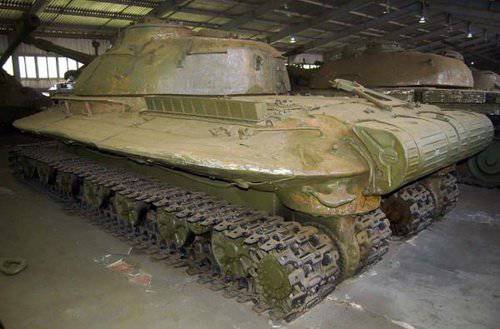
The design of the tank had a classic layout. But the applied original design solutions led to the fact that the 11,47 cubic meter booking capacity was actually the smallest among all heavy tanks of those years (can be attributed to the drawbacks). The hull of the tank was a cast construction of solid parts 4, connected by welding. Spaced steel screens with a curvilinear profile were installed on the sides of the tank. These screens were designed to provide additional protivokumulyativnuyu protection, at the same time, giving the body a streamlined shape. The tank was extremely powerful booking. The frontal armor had a normal thickness of 192 mm (in some sources 269 mm is indicated, which seems to be too high) it had a slope of 60 degrees and a turning angle to 45 degrees. The actual reduced armor thickness was equivalent to 384-550 mm. Tank sides were defended with 182-mm armor with a slope of about 45 degrees (equivalent to booking in 260 mm). This level of reservation guaranteed the tank’s invincibility when firing from any tank weapon available at that time from any distance.
The tank turret was hemispherical, solid and flattened. The turret had a uniform thickness of armor in 305 mm, and a slope in 30 degrees (equivalent to 352 mm). Thanks to this, the 279 Object obtained a record level of security that was achieved without using a combined reservation. At the same time, the mass of the tank was 60 tons, which seems even a trifle in comparison with such German developments as the “Maus” or E-100.
The crew of the heavy tank consisted of a 4 man. Three of them were located in the tower (commander, loader and gunner), and the fourth - the driver was in front of the case in the center. Here was his hatch for landing and disembarking from a tank.
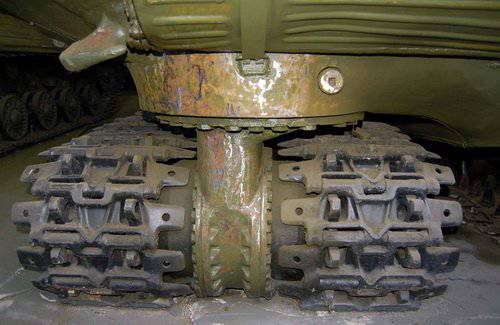
The main armament of the tank was to be the 130-mm rifled M-65 gun. With the gun was paired 14,5-mm machine gun KPVT. This tool was developed in the second half of the 50-ies for the arming of promising heavy tanks and PT-ACS. The weight of the gun was 4060 kg, and the length was approximately equal to 60 caliber. Its features were the presence of a slotted muzzle brake, auxiliary purging of the barrel with compressed air and an ejector. The barrel muzzle energy was 15-16 MJ, and 30,7 kg. an armor-piercing tracer projectile left it at a speed of 1000 m / s. The muzzle energy of an instrument is 1,5 times the performance of modern 120-125-mm smooth-bore guns.
The ammunition feed process was partially automated. The joint operation of the cluster semi-automatic loader and loader made it possible to achieve a rate of fire in 5-7 shots per minute. At the same time, a more complex loader system was developed, which would allow the rate of fire to be increased to 10-15 per minute. At the same time, in payment for the very tight layout, the tank ammunition was quite modest - the entire 24 shot of separate loading and 300 cartridges for the machine gun.
The tank was supposed to use modern at that time aiming and observation devices: a stereoscopic rangefinder TPD-2С, having independent stabilization, a two-plane electro-hydraulic stabilizer “Thunderstorm”, a nighttime sight TPLN, combined with an L-2 IR illuminator, and a semi-automatic OMS. Many of these devices appeared on serial machines only at the end of the 60-s.
The main engine for the tank was 2 diesel engines: 2ДГ-8М (1000 hp at 2400 rpm) and DG-1000 (950 hp at 2500 rpm). Both engines had a horizontal arrangement of cylinders (in order to save space in the low tank case) and could provide the tank with a travel speed on the highway in 50-55 km / h. The power reserve of the machine was 250-300 km. Instead of a mechanical transmission, the tank received a single-flow three-stage hydromechanical transmission. The planetary gearbox was partially automated.
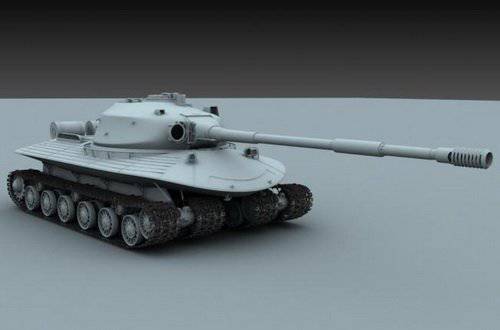
The main highlight of the project was the undercarriage, which was located on 4 tracked engines located under the bottom of the hull. On each side of the tank there was a block of 2 tracked thrusters, each of which included 6 dual non-rubber support rollers and 3 supporting rollers. The drive wheel had a rear location. Such a chassis had no analogues in the domestic tank building. The undercarriage units were mounted on 2's supporting structures, which concurrently served as fuel tanks. The tank suspension was hydropneumatic. The undercarriage design provided the tank with an almost complete lack of ground clearance, the impossibility of its landing on the ground and a relatively low specific pressure at the level of 0,6 kg / sq. cm.
According to the results of the tests that took place in 1959, the tank revealed a number of serious deficiencies in the undercarriage. In particular, the loss of efficiency when driving on viscous soil, low turning power, difficulty of maintenance and repair, the impossibility of reducing the overall height of the tank and the greater complexity of production. Already then it became clear that the "279 Object" was not destined to become a serial tank. The most highly specialized, ambitious and expensive among all three prototypes, he had to give way to them.
But these plans have not come true. 22 July 1960 of the year during the demonstration of new heavy equipment at the Kapustin Yar Khrushchev range strictly forbade the military to use any tanks exceeding 37 tons in mass. Thus, the USSR put an end to the whole program of heavy tanks. However, in spite of this, the “279 Object” for many years, up to the appearance on the armament of the T-80 tanks, remained one of the most powerful tanks in the world.
Information